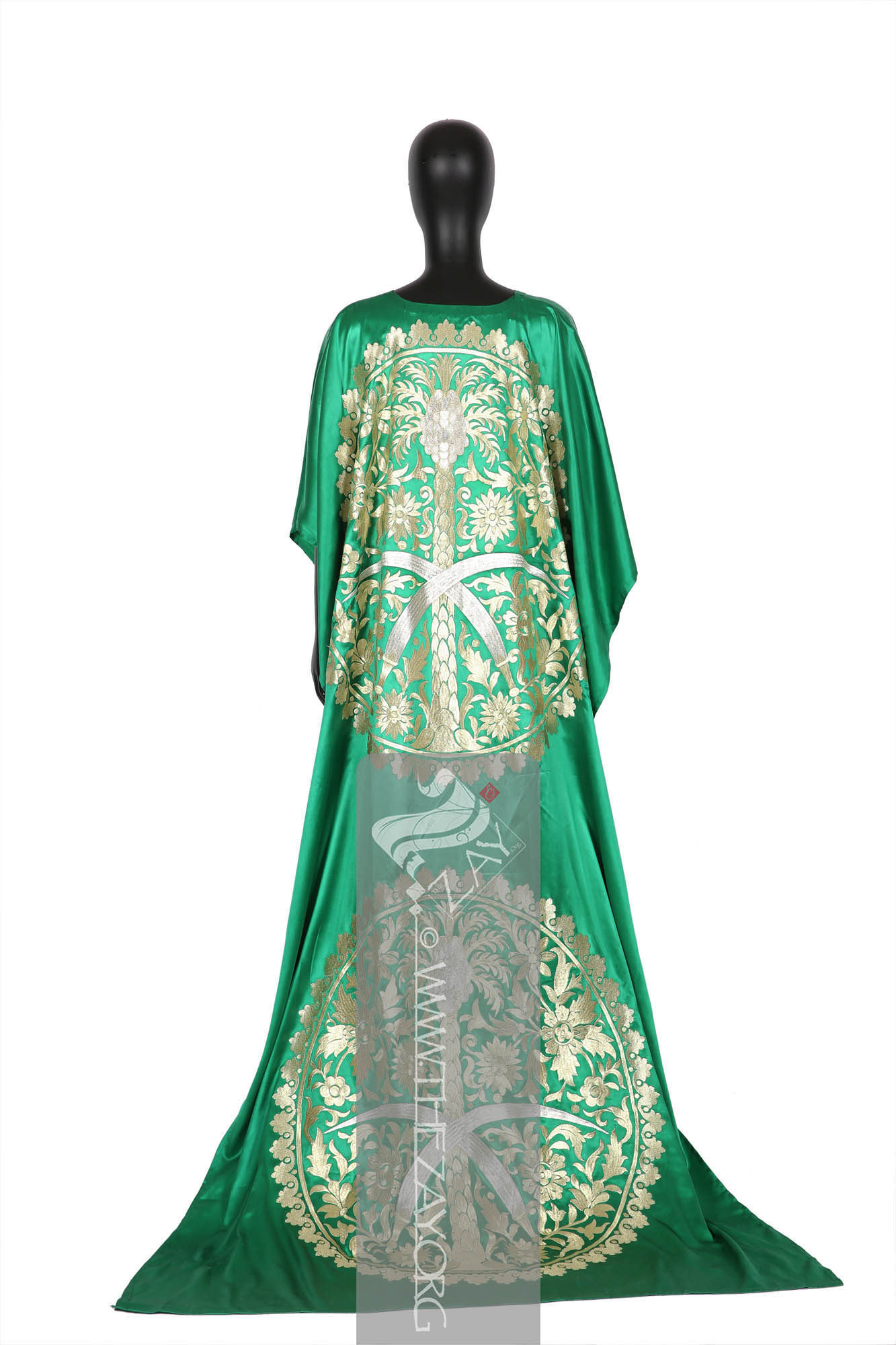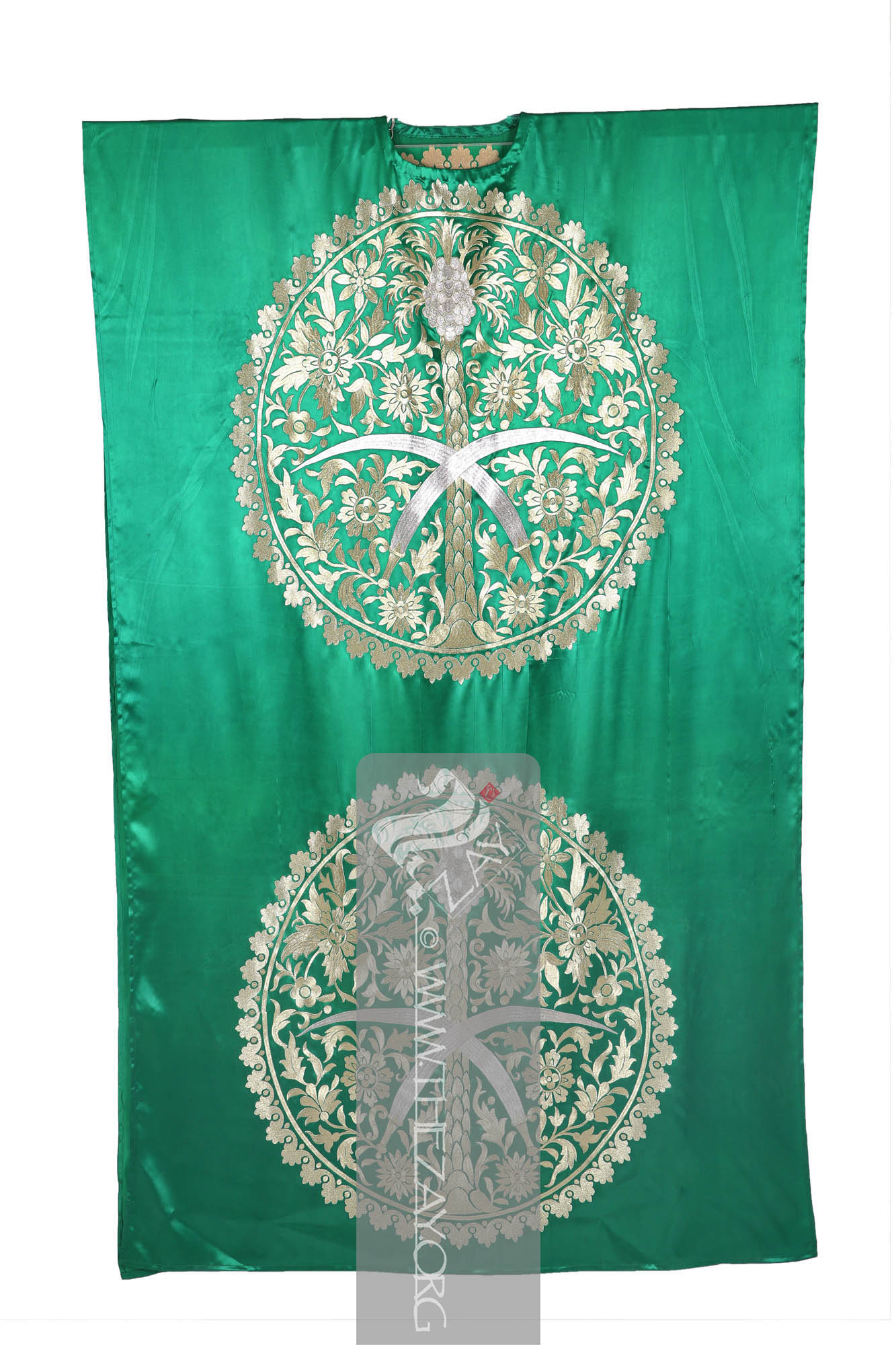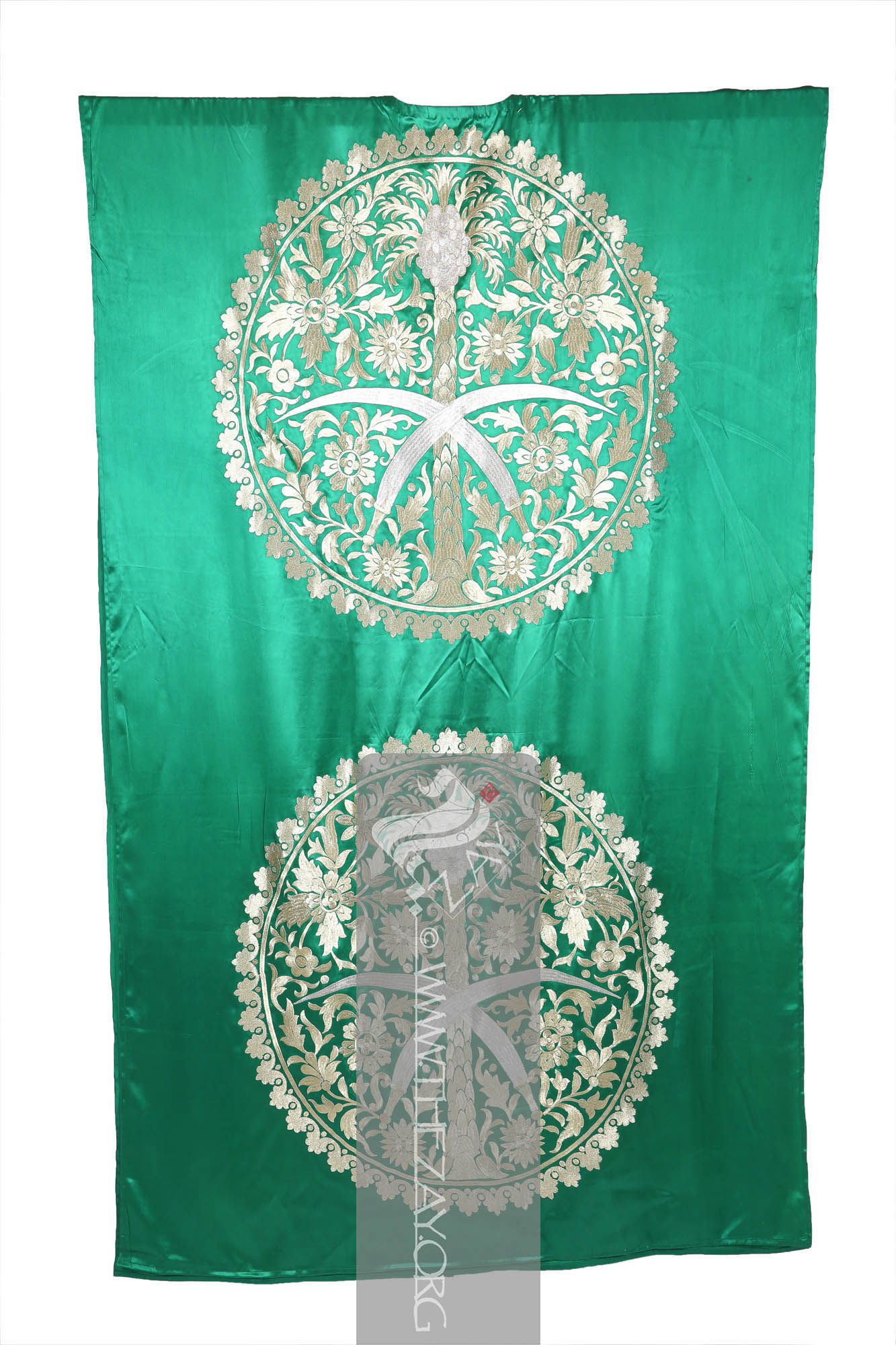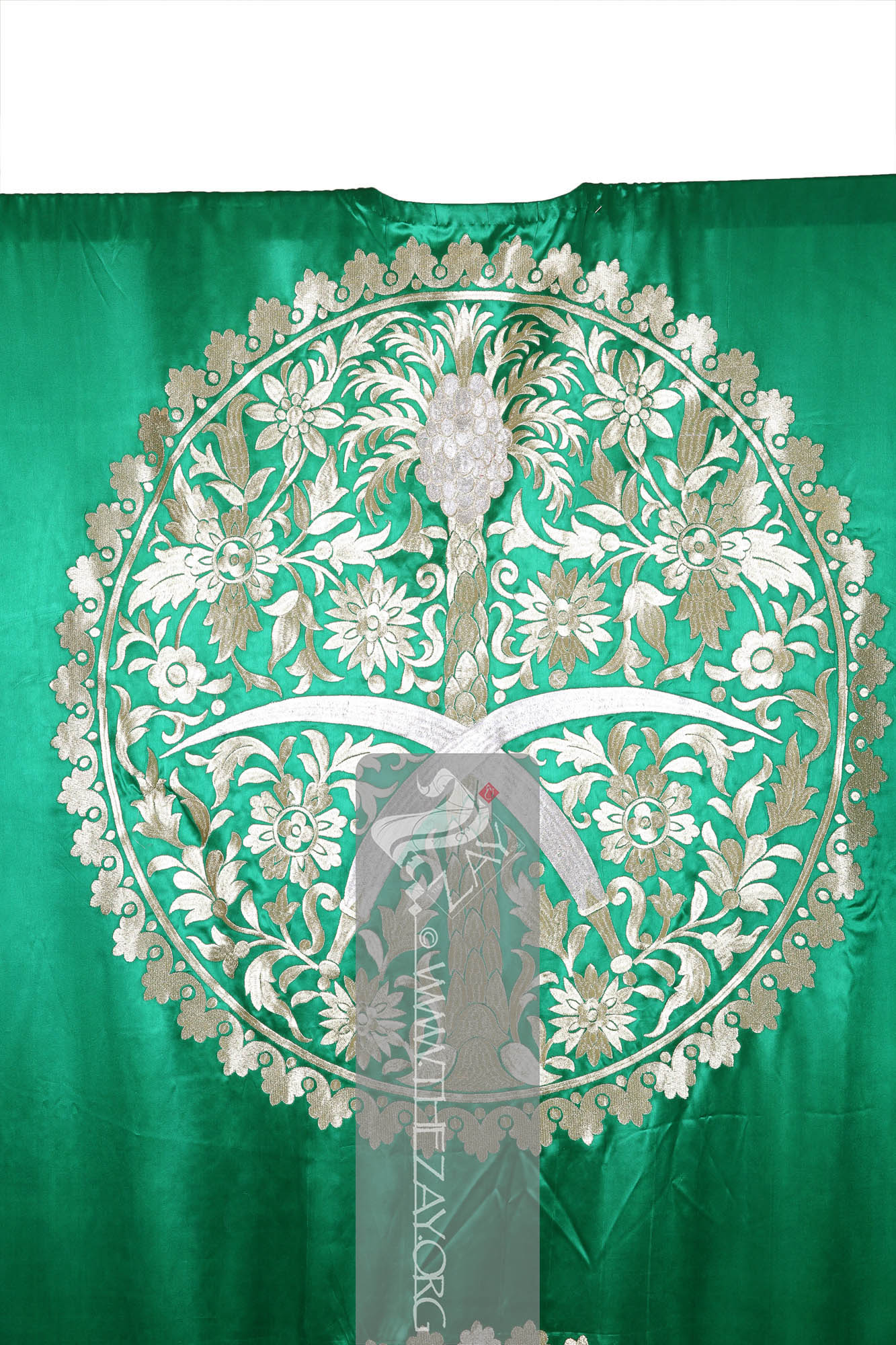Object History Dr. Reem Tariq
Ṭariq: (Arabic; Synonym: tulle_bi_talli
Tūlle_bi_tallī: (French: Tulle – a city in France where fine material for veil was first made; Turkish: tel – wire; Synonym: tariq; talli; badla; khus_dozi ), series of small metal knots made on a woven net ground as embellishment. The term is commonly used in the North African Arab region specifically in Egypt.
; talli; badla; khus_dozi ), series of small metal knots made on a woven net ground as embellishment. The term is commonly used in the Levant Arab region specifically in Lebanon.
El Mutwalli
Dr. Reem Tariq
Ṭariq: (Arabic; Synonym: tulle_bi_talli
Tūlle_bi_tallī: (French: Tulle – a city in France where fine material for veil was first made; Turkish: tel – wire; Synonym: tariq; talli; badla; khus_dozi ), series of small metal knots made on a woven net ground as embellishment. The term is commonly used in the North African Arab region specifically in Egypt.
; talli; badla; khus_dozi ), series of small metal knots made on a woven net ground as embellishment. The term is commonly used in the Levant Arab region specifically in Lebanon.
el Mutwallī: Founder (CEO) of the Zay
Zay: (Arabic: costume, Pl. azyaā’), a set of clothes in a style typical of a particular country or historical period. Initiative, a public figure, speaker and author. An expert curator and consultant in Islamic art and architecture, interior design, historic costume, and UAE heritage. purchased this overgarment (
thawb
Thawb: (Arabic: thawb, Pl. Athwāb/thībān), can be pronounced thobe
Thobe: (Arabic: thawb, Pl. Athwāb/thībān), can be pronounced thawb or tobe
Tobe: (Arabic: thawb, Pl. Athwāb/thībān), can be pronounced thawb or thobe based on locale. The standard Arabic word for ‘fabric’ or ‘garment’. It can refer to a qamīs-like tunic worn by men and women in the Arabian Peninsula, Iraq, the southern and south-western ports and islands of Iran, and some countries in East and West Africa. More specifically, it can refer to the square-shaped Bedouin overgarment worn by women. based on locale. The standard Arabic word for ‘fabric’ or ‘garment’. It can also refer to a qamīs-like tunic worn by men and women in the Arabian Peninsula, Iraq, the southern and south-western ports and islands of Iran, and some countries in East and West Africa. More specifically, it can refer to the square-shaped Bedouin overgarment worn by women. or tobe
Tobe: (Arabic: thawb, Pl. Athwāb/thībān), can be pronounced thawb or thobe based on locale. The standard Arabic word for ‘fabric’ or ‘garment’. It can refer to a qamīs-like tunic worn by men and women in the Arabian Peninsula, Iraq, the southern and south-western ports and islands of Iran, and some countries in East and West Africa. More specifically, it can refer to the square-shaped Bedouin overgarment worn by women. based on locale. The standard Arabic word for ‘fabric’ or ‘garment’. It can also refer to a qamīs-like tunic worn by men and women in the Arabian Peninsula, Iraq, the southern and south-western ports and islands of Iran, and some countries in East and West Africa. More specifically, it can refer to the square-shaped Bedouin overgarment worn by women in the Arabian Gulf region. ) from a Saudi Arabian fabric dealer while browsing on Instagram. The dealer had specifically ordered this type of fabric, in hopes of preserving the production of old patterns.
Object Features (
Sufrat_S’ud
Sufrat_S’ūd: (Arabic: sufrah: table or mat, S’ūd: male name), meaning s’ud’s mat, in reference to woven or embroidered medallions in a metallic thread (zari
Zarī: (Persian two-syllables: zar: gold & dozi: embellishment), complex embroidery technique that uses metal alloy on silk, satin, or velvet, and may include pearls, beads, and precious stones. Colloquially in the Arab gulf region, the term (zarī) is loosely applied to any gilded thread, embellishment or gilded brocade fabric. Originated in ancient Persia it has been used extensively in Indian and Middle Eastern textiles for centuries. ) or (kantil), resembling palm frond mats for serving food. Originally decorated in floral and plant motif, post establishment of Saudi Arabia, two intersecting swords and a central palm tree became prevalent. Woven in India by special request of King Saud bin Abdulaziz Al Saud, to gift his wife, Princess Jamila bint Asa’ad bin Ibrahim Mareyi, eventually becoming an official royal gift.) is the main emphasis of this overgarment (
thawb
Thawb: (Arabic: thawb, Pl. Athwāb/thībān), can be pronounced thobe
Thobe: (Arabic: thawb, Pl. Athwāb/thībān), can be pronounced thawb or tobe
Tobe: (Arabic: thawb, Pl. Athwāb/thībān), can be pronounced thawb or thobe based on locale. The standard Arabic word for ‘fabric’ or ‘garment’. It can refer to a qamīs-like tunic worn by men and women in the Arabian Peninsula, Iraq, the southern and south-western ports and islands of Iran, and some countries in East and West Africa. More specifically, it can refer to the square-shaped Bedouin overgarment worn by women. based on locale. The standard Arabic word for ‘fabric’ or ‘garment’. It can also refer to a qamīs-like tunic worn by men and women in the Arabian Peninsula, Iraq, the southern and south-western ports and islands of Iran, and some countries in East and West Africa. More specifically, it can refer to the square-shaped Bedouin overgarment worn by women. or tobe
Tobe: (Arabic: thawb, Pl. Athwāb/thībān), can be pronounced thawb or thobe based on locale. The standard Arabic word for ‘fabric’ or ‘garment’. It can refer to a qamīs-like tunic worn by men and women in the Arabian Peninsula, Iraq, the southern and south-western ports and islands of Iran, and some countries in East and West Africa. More specifically, it can refer to the square-shaped Bedouin overgarment worn by women. based on locale. The standard Arabic word for ‘fabric’ or ‘garment’. It can also refer to a qamīs-like tunic worn by men and women in the Arabian Peninsula, Iraq, the southern and south-western ports and islands of Iran, and some countries in East and West Africa. More specifically, it can refer to the square-shaped Bedouin overgarment worn by women in the Arabian Gulf region. ), also known as (
kurtat_S’ud
Kurtah_S’ūd: (Urdu and Persian: kurta, Arabic: S’ud: male name), colloquially in Saudi Arabia, the term refers to a waist cinched dress with (Sufrat_S’ud
Sufrat_S’ūd: (Arabic: sufrah: table or mat, S’ūd: male name), meaning s’ud’s mat, in reference to woven or embroidered medallions in a metallic thread (zari
Zarī: (Persian two-syllables: zar: gold & dozi: embellishment), complex embroidery technique that uses metal alloy on silk, satin, or velvet, and may include pearls, beads, and precious stones. Colloquially in the Arab gulf region, the term (zarī) is loosely applied to any gilded thread, embellishment or gilded brocade fabric. Originated in ancient Persia it has been used extensively in Indian and Middle Eastern textiles for centuries. ) or (kantil), resembling palm frond mats for serving food. Originally decorated in floral and plant motif, post establishment of Saudi Arabia, two intersecting swords and a central palm tree became prevalent. Woven in India by special request of King Saud bin Abdulaziz Al Saud, to gift his wife, Princess Jamila bint Asa’ad bin Ibrahim Mareyi, eventually becoming an official royal gift.) motif.) when applied on a waist-cinched dress, popular in Najd, Saudi Arabia. The emerald, green
satin
Sātin: (Arabic: Zaytuni: from Chinese port of Zayton in Quanzhou province where it was exported from and acquired by Arab merchants), one of the three basic types of woven fabric with a glossy top surface and a dull back. Originated in China and was fundamentally woven in silk. silk fabric is machine embroidered into four large medallions, using gold metallic thread (
Zari
Zarī: (Persian two-syllables: zar: gold & dozi: embellishment), complex embroidery technique that uses metal alloy on silk, satin, or velvet, and may include pearls, beads, and precious stones. Colloquially in the Arab gulf region, the term (zarī) is loosely applied to any gilded thread, embellishment or gilded brocade fabric. Originated in ancient Persia it has been used extensively in Indian and Middle Eastern textiles for centuries. ), known as (
kantil
Kantīl: (colloquial Hijazi), a term referring to embroidery with gold or silver thread, also known as (zari
Zarī: (Persian two-syllables: zar: gold & dozi: embellishment), complex embroidery technique that uses metal alloy on silk, satin, or velvet, and may include pearls, beads, and precious stones. Colloquially in the Arab gulf region, the term (zarī) is loosely applied to any gilded thread, embellishment or gilded brocade fabric. Originated in ancient Persia it has been used extensively in Indian and Middle Eastern textiles for centuries. ). The term is equally used in Morocco and Algeria.) locally. The article exemplifies national pride.
The overall simple shape is derived by plainly folding the length of the fabric and cutting an opening at the centre of the fold to allow the head to pass through, creating the neckline. The two outer edges of the folded fabric are then stitched from the hip line down the lower hemline, on both sides, creating two large openings for the hands to pass through forming the quintessential wide sleeves. The four embroidered medallions are placed proportionately two in the front and two in the back.
Green symbolises the heavens in Islam, a reflection of nature and life in general. Traditionally, women of the Arab gulf region elect to wear green for their ceremonial henna night (
laylat_al_hinnah
Laylat_Al_ḥinnah: (Arabic: laylat: night, ḥinnah: henna), a ceremonial ritual celebrated among family and close friends, carried out in the days before bride's wedding night. The hands and feet are decorated using henna paste as an integral part of the ceremony.) or to mark the middle of (
Sha
Sha: It is a gauze like sheer silk fabric characterised by its crispness. It is often used to make unlined summer, generally informal, kimonos. ’ban) and the first night of (
Ramadan
Ramaḍān: (Arabic), a name given to the ninth month of the Islamic calendar, observed by Muslims worldwide as a month of fasting. ).
More InformationsAlghalib, L. F., Alireza, H., & Wilding, R. (Eds.). Traditional costumes of Saudi Arabia: The Mansoojat Foundation Collection. ACC Art Books, 2021.
kantil
Kantīl: (colloquial Hijazi), a term referring to embroidery with gold or silver thread, also known as (zari
Zarī: (Persian two-syllables: zar: gold & dozi: embellishment), complex embroidery technique that uses metal alloy on silk, satin, or velvet, and may include pearls, beads, and precious stones. Colloquially in the Arab gulf region, the term (zarī) is loosely applied to any gilded thread, embellishment or gilded brocade fabric. Originated in ancient Persia it has been used extensively in Indian and Middle Eastern textiles for centuries. ). The term is equally used in Morocco and Algeria.:
youtube video link 









